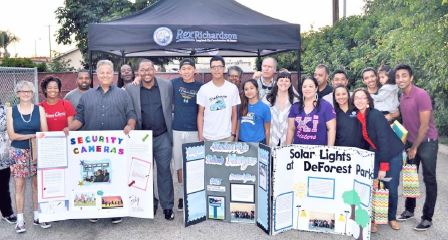University student at California State University in Long Beach, Jessica Bracho has participated as a budget facilitator for PB Long Beach. Studying Sociology, she worked closely with PB researcher Professor Gary Hytrek who sparked her interest in community development. Jessica shares the valuable lessons learned in making PB inclusive and a great experience for all community members.

PBP: Why did you get involved in PB?
Jessica: I was a student of Professor Gary Hytrek who helped jumpstart PB in Long Beach for the first time. He offered students the chance to get involved in the first PB pilot where I took up the opportunity to volunteer as a budget facilitator. Having done facilitation training for other nonprofits, I thought this would be a unique experience guiding the initial phases of PB in Long Beach. Through my experience as a facilitator, I think it’s amazing that as a student I am able to volunteer my time towards something valuable that benefits my community.
PBP: Can you describe the role of a facilitator?
Jessica: Other facilitators and I would make sure that community members had a safe space for everyone to speak and contribute ideas while also pushing goals forward. The bulk of the work happens after the meeting where we follow up with the work delegates have done, like their research and proposal drafts. But often times I was there for moral support which is a role I did not expect to have. Since it’s a process led by the people, I can give them the support they need to move their ideas forward.
We had groups of really engaged and strong voices coming into PB with an agenda that they had already. Most of these groups were already part of neighborhood associations who had established their networks within the community and the City Council office. As a facilitator, my role was to make sure everyone’s voice was heard. In order to do this, we asked the delegates to look at the demographics and assets of the community. At times that was difficult for them because they had an idea of what PB was and what they wanted to see on the ballot. We struggled at first to reconcile that. Towards the end, more people were willing to fight for projects that spoke to the diverse needs of the community.
PBP: What projects were most important to the community?
Jessica: A majority of ideas during the first cycle had to do with safety, for instance improving lighting in alleys or parks, establishing a need for traffic signs and security cameras near schools. Community members were trying to find a way to make their district feel safer and PB provided a platform for them. The way PB can support these needs is through funding brick and mortar projects that address the desire for a safer neighborhood. It’s interesting to note that being involved in the PB process and getting to know your neighbors can also contribute to a sense of safety. Beautification projects were also supported by many of the neighborhood groups which also landed on the ballot.
PBP: In what ways is PB successful?
Jessica: PB is a process that voices the concerns of a community. Rather than just observing these concerns, it provides a platform to take action. PB enabled people from differing income, racial and religious backgrounds to express their concerns, meet with other community members and support each other.
What comes to mind is a computer lab project developed by a group from the local church. The church wanted a computer lab for their space. When we looked at the idea list, we saw that others had also wanted computers at a neighboring park. They had some technology at the parks community center but not enough to meet the demands of the people. Members of the church had networks within the community to support their project. In order to increase access to these resources, the church group was able to add onto to their project and call for expanding the computer and tablet center at the neighboring park. They took an idea that was important to them and expanded it to accommodate to community members who didn’t have a collective voice previously.
PBP: How does PB open opportunities within Long Beach?
Jessica: In the early stages, we were seeing the same people involved as delegates on a district committee. While it was great that residents were getting involved, it was difficult getting new people onboard. Later on in the process, people from the neighborhood assemblies who had not volunteered as budget delegates came back again for the vote. I think that was a great opportunity for community building. It helps gets new people involved. We did see a couple of members who had voted in the first cycle become delegates for round two. I hope PB Long Beach can continue to build a community of people who are aware of what is going on in their neighborhood and are eager to get involved in any way they can.
PBP: Is there anything else you’d like to add?
Jessica: PB has a lot of promise in Long Beach as it creates stronger civic networks. Most of the facilitators for PB came from Cal State Long Beach thanks to Professor Hytrek. As students we have a bit more free time and can help keep the process alive. I believe universities should be involved in PB as it’s a great learning experience.





